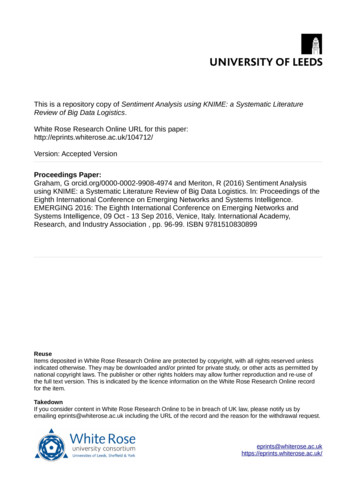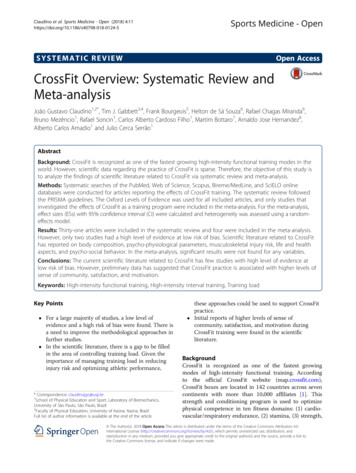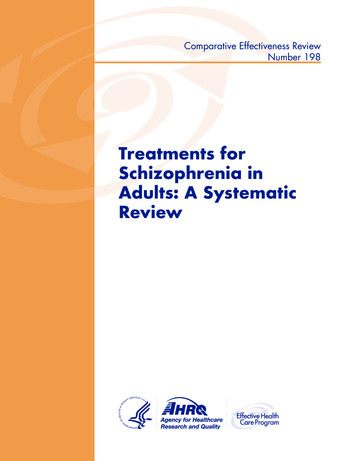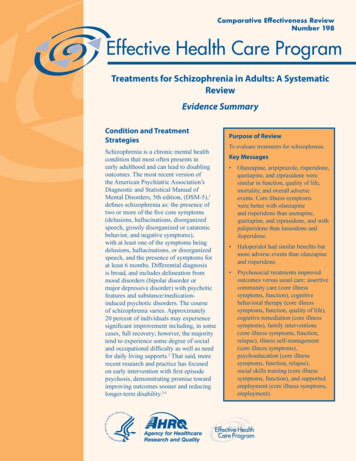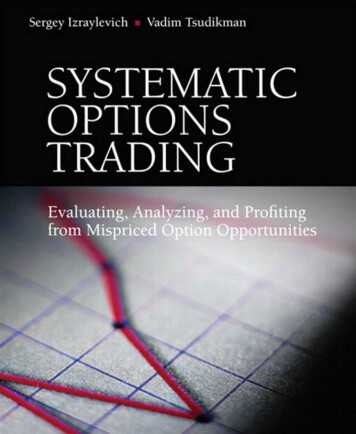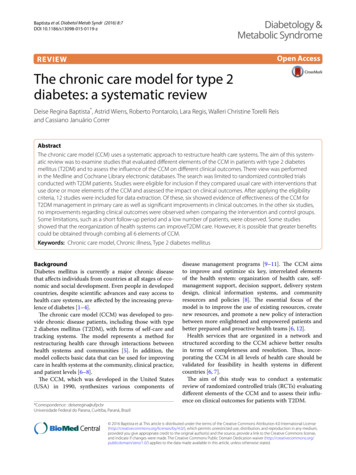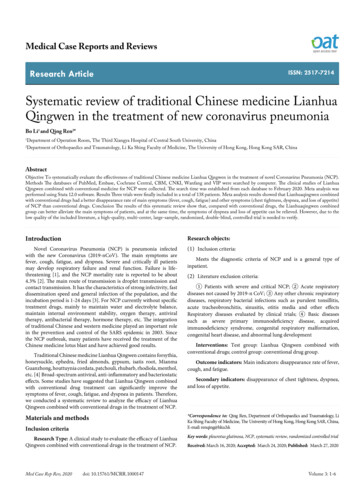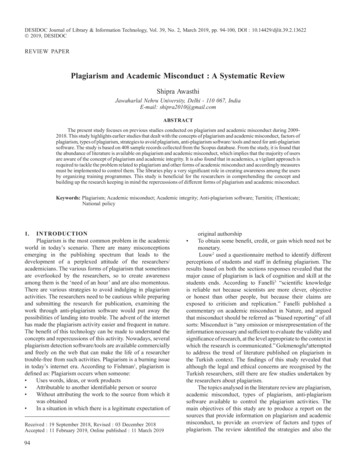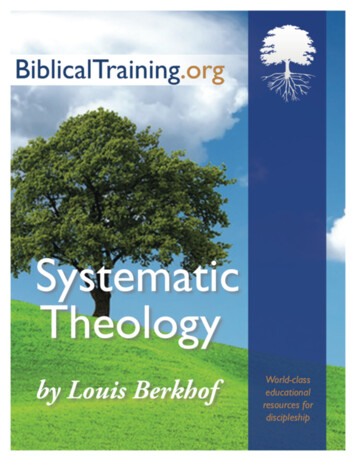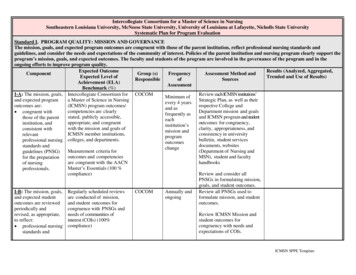
Transcription
Intercollegiate Consortium for a Master of Science in NursingSoutheastern Louisiana University, McNeese State University, University of Louisiana at Lafayette, Nicholls State UniversitySystematic Plan for Program EvaluationStandard I. PROGRAM QUALITY: MISSION AND GOVERNANCEThe mission, goals, and expected program outcomes are congruent with those of the parent institution, reflect professional nursing standards andguidelines, and consider the needs and expectations of the community of interest. Policies of the parent institution and nursing program clearly support theprogram’s mission, goals, and expected outcomes. The faculty and students of the program are involved in the governance of the program and in theongoing efforts to improve program quality.Expected OutcomeResults (Analyzed, Aggregated,ComponentGroup (s)FrequencyAssessment Method andExpected Level ofTrended and Use of Results)ResponsibleofSourcesAchievement (ELA)AssessmentBenchmark (%)I-A: The mission, goals, Intercollegiate Consortium for COCOMReview each ICMSN institutions’Minimum ofand expected programa Master of Science in NursingStrategic Plan, as well as theirevery 4 yearsoutcomes are:(ICMSN) program outcomes/respective College andand ascompetenciesareclearlyDepartment mission and goals congruent withfrequently asstated,publiclyaccessible,and ICMSN program and studentthose of the parenteachappropriate, and congruentoutcomes for congruency,institution, andinstitution’swith the mission and goals ofclarity, appropriateness, andconsistent withmission andICMSN member institutions,consistency in universityrelevantprogrambulletin, student servicesprofessional nursing colleges, and departments.outcomesdocuments, websitesstandards andchangeMeasurementcriteriafor(Department of Nursing andguidelines (PNSG)outcomes and competenciesMSN), student and facultyfor the preparationare congruent with the AACNhandbooksof nursingMaster’s Essentials (100 %professionals.compliance)Review and consider allPNSGs in formulating mission,goals, and student outcomes.I-B: The mission, goals, Regularly scheduled reviewsCOCOMAnnually and Review all PNSGs used toand expected studentare conducted of mission,ongoingformulate mission, and studentoutcomes are reviewedand student outcomes foroutcomes.periodically andcongruence with PNSGs andrevised, as appropriate,needs of communities ofReview ICMSN Mission andto reflect:interest (COIs) (100%student outcomes forcongruency with needs and professional nursing compliance)expectations of COIs.standards andICMSN SPPE Template
uidelines (PNSG)and the needs andexpectations of thecommunity ofinterestI-C: Expected facultyoutcomes are clearlyidentified by the nursingunit, are written andcommunicated to thefaculty and arecongruent withinstitutionalexpectationsI-D: Faculty andstudents participate inprogram governance.Obtain input/data from COIsvia:o Graduate Exit Surveyo Employer Surveyo Alumni SurveyPolicies affecting the ICMSNfaculty are either congruentwith those of the governingorganization or rationales forpolicies that differ for thegoverning organization exist(100% compliance)All ICMSN faculty areprovided with job descriptionsand evaluation rubrics, whichare aligned with respectiveICMSN universityexpectations for faculty,including guidelines for tenureand promotion.(100 % compliance)ICMSN Graduate FacultyOrganization Bylaws reflectfaculty participation inprogram governance throughcommittee positions: All ICMSN standingcommittees, exclusive ofthe CoordinatingCommittee, include facultyrepresentation from eachuniversity (100%compliance)DACAnnuallyDept. HeadsCOCOMOngoingReview of documents fromeach ICMSN institution’s:o Appointment,Promotion and Tenurepolicieso Department of Nursing(DON) Handbooko DON rubrics forTeaching, Research,and Service for FacultyEvaluationReview of:ooooooooICMSN BylawsICMSN Organizational chartCommittee Membership listMeeting minutesGFO minutesGraduate Exit SurveyStudent handbookFaculty handbookICMSN SPPE Template
All ICMSN faculty aremembers of the GraduateFaculty Organization(GFO) (100% compliance)ICMSN student representationis encouraged on ICMSNcommittee student positions,student discussion group,university, college, anddepartmental committees.I-E: Documents andpublications areaccurate. A process isused to notifyconstituents aboutchanges in documentsand publications.I-F: Academic policiesof the parent institutionand the nursing programare congruent andsupport achievement of All ICMSN standingcommittees, exclusive of theCoordinating Committee,have graduate studentrepresentation. (100%compliance)All publications (written andCCCOMelectronic) are reviewedperiodically for accuracy.Faculty, students, andconstituents are notified ofany changes via meetings,assemblies, writtendocumentation, or acombination of thepreceding, as indicated.(100% compliance)Respective ICMSN university,college and departmentalpolicies are published andregularly reviewed to ensurecongruence with the ICMSNDept.HeadsOngoingAnnuallyReview for documents:o Published programmaterialso Websiteso Catalogs (online)o Syllabio Student Handbooko Faculty Handbookso Learning ManagementSystem (LMS) coursesitesReview of documents:o Faculty handbooko University catalogs(online)o Student handbooksICMSN SPPE Template
the mission, goals, andexpected studentoutcomes. Thesepolicies are: fair, equitable;published andaccessible;reviewed and revised asnecessary to fosterprogram improvement.program mission, goals andexpected outcomes. Revisionsare made as indicated (100%compliance)o Published programmaterialso Syllabio ICMSN websiteo LMS Course sitesICMSN SPPE Template
Intercollegiate Consortium for a Master of Science in NursingSoutheastern Louisiana University, McNeese State University, University of Louisiana at Lafayette, Nicholls State UniversitySystematic Plan for Program EvaluationSTANDARD II. PROGRAM QUALITY: INSTITUTIONAL COMMITMENT AND RESOURCESThe parent institution demonstrates ongoing commitment and support for the nursing program. The institution makes available resources to enable theprogram to achieve its mission, goals, and expected aggregate student and faculty outcomes. The faculty, as a resource of the program, enables theachievement of the mission, goals, and expected aggregate student outcomes.Expected OutcomeResults (Analyzed, Aggregated,ComponentGroup (s)FrequencyAssessment MethodTrended and Use of Results)Expected Level ofResponsibleofAchievement BenchmarkAssessmentII-A. Fiscal and physicalresources are sufficientto enable the program tofulfill its mission, goals,and expected outcomes.Adequacy of resources isreviewed periodicallyand resources modifiedas needed.II-B. Academic supportservices are sufficient toensure quality and areevaluated on a regularAdequate fiscal resourcesare consistently availableDeansAnnually andongoingAdequate physical resourcesexist for student/faculty needsAcademic support servicesare adequate to meet programand student needsDeansAnnually andongoingReview of institutions’:o Nursing unit operatingbudgeto Equipment allocation fundso Research fundingo Grantso Travel funding andexpenditureso Teaching assignmentso Personnel budget andassignmentso Classroom space, labs,offices, and storagespaceo Library resourcesObtain data from:o Student Evaluation ofInstruction (SEI)o Graduate Exit SurveyReview of:o University anddepartmental budgetso SEIICMSN SPPE Template
basis to meet programand student needs.II-C. The chief nurseadministrator: Is a registered nurse(RN); Holds a graduatedegree in nursing; Holds a doctoraldegree if the nursingunit offers agraduate program innursing; Is academically andexperientiallyqualified toaccomplish themission, goals, andexpected student andfaculty outcomes; Is vested with theadministrativeauthority toaccomplish themission, goals, andexpected programoutcomes; and 80% of Graduate ExitSurvey respondents willindicate strongly agree oragree that library resourcessupported student learningneeds ((old tool question # 2,item #11) or item # 16)The institution’s Chief NurseAdministrator must continueto hold necessaryqualifications (100%compliance)o Graduate Exit SurveyDACUpon hireandannuallyReview of documents:o Transcriptso Vitaeo LSBN licensureverificationProvides effectiveleadership to the nursingunit in achieving itsICMSN SPPE Template
mission, goals, andprogram outcomes.II-D. Faculty are: Sufficient in numberto accomplish themission, goals, andprogram outcomes; Academicallyprepared for theareas in which theyteach; andExperientially preparedfor the areas in whichthey teach.II-E. Preceptors, whenused by the program asan extension of faculty,are academically andexperientially qualifiedfor their role in assistingin the achievement of themission, goals, andexpected studentoutcomes.II-F. The parentinstitution and programprovide and support anenvironment thatencourages facultyteaching, scholarship,service, and practice inkeeping with themission, goals, andSufficient numbers ofqualified faculty with roleand functional preparation inthe area of teachingICMSN faculty have roleand functional preparation inarea of teaching assignmentand adhere to LouisianaState Board of Nursing(LSBN) rules andregulations (100%compliance)ICMSN preceptorsare academically andexperientially qualified withrole and functional preparationin the area of teaching (100%compliance)The institution provides asupportive environment thatencourages ongoing facultylearning, engagement &scholarship. 80 % of FacultySatisfaction Surveyrespondents will stronglyDept. HeadsOngoingReview of:o Faculty vitaeo Faculty transcriptso Teaching assignmentso CE recordso Licensureo CertificationDirectors ofReview of:Annually andNPo Preceptor Vitaeongoingconcentrationso Preceptor Letter ofAgreemento Student evaluation ofpreceptoro Faculty evaluation ofpreceptorDACOngoingReview of:o Faculty handbooko Faculty vitaeo Promotion and tenureapplicationso Workload documentsFaculty performanceevaluationsICMSN SPPE Template
expected facultyoutcomes.agree or agree thatadministrative support isadequate to assist faculty inmeeting the program’smission, goals, and expectedoutcomes (item # 4)ICMSN SPPE Template
Intercollegiate Consortium for a Master of Science in NursingSoutheastern Louisiana University, McNeese State University, University of Louisiana at Lafayette, Nicholls State UniversitySystematic Plan for Program EvaluationSTANDARD III: PROGRAM QUALITY: CURRICULUM AND TEACHING-LEARNING PRACTICESThe curriculum is developed in accordance with the mission, goals, and expected aggregate student outcomes. The curriculum reflects professionalnursing standards and guidelines and the needs and expectations of the community of interest. Teaching-learning practices are congruent with expectedstudent. The environment for teaching-learning fosters achievement of expected student outcomes.ComponentExpected OutcomeExpected Level ofAchievement BenchmarkIII-A. The curriculum isdeveloped, implemented,and revised to reflectclear statements ofexpected individualstudent learningoutcomes that arecongruent with theprogram’s mission,goals, and with the rolesfor which the program ispreparing its graduates.Measurement criteria forstudent learning outcomesand competencies arecongruent with:Essentials of Master’sEducation in Nursing(AACN, 2011)Criteria for Evaluation ofNurse PractitionerPrograms (NTF, Annually andongoingAssessment MethodResults (Analyzed, Aggregated,Trended and Use of Results)Review of:o ICMSN Mission & Goalso ICMSN ProgramOutcomeso ICMSN Student LearningOutcomeso Course syllabio SEIo End of Course (EOC)evaluationsCore Competencies for NurseEducators (NLN, 2013)Nurse Executive Competencies(AONE, 2015)Graduate Quality and SafetyEducation for Nurses (QSEN)Competencies (AACN, 2012)100% complianceICMSN SPPE Template
III-B. Curricula aredeveloped, implemented,and revised to reflectrelevant professionalnursing standards andguidelines, which areclearly evident within thecurriculum and withinthe expected studentoutcomes (individual andaggregate)Master’s programcurricula incorporateprofessional standardsand guidelines asappropriate.A. All master’sprogramsincorporate TheEssentials ofMaster’s Educationin Nursing (AACN,2011) andadditional relevantprofessionalstandards andguidelines asidentified by theprogram.B. All master’s degreeprograms thatprepare nursepractitionersCriteria forMeasurement criteria for theMSN curricula arecongruent with:Essentials of Master’sEducation in Nursing (AACN,2011).CUCOMAnnually andongoingReview of:o Program outcomeso Student learning outcomeso Curriculumo Course syllabiProfessional NursingStandards and Guidelines(PNSG):Scope and Standards ofPractice (ANA, 2015)Scope and Standards ofPractice for Psychiatric Mental Health Nursing (ANA,2014)LSBN Rules and RegulationsGraduate Quality SafetyEducation for Nurses (QSEN)(AACN, 2012)Nurse Practitioner CoreCompetencies (NONPF, 2017)Nurse Executive Competencies(AONE, 2015)Criteria for Evaluation ofNursing PractitionerPrograms (NTF, 2012)100 % complianceICMSN SPPE Template
Evaluation of NursePractitionerPrograms (NTF,2012).C. Graduate-entryprogram curriculaincorporate TheEssentials ofBaccalaureateEducation forProfessional NursingPractice (AACN,2011) andappropriate graduateprogram standardsand guidelinesD. Post-graduateAPRN certificateprograms thatprepare nursepractitionersincorporate Criteriafor Evaluation ofNurse PractitionerPrograms (NTF,2012).III-C. The curriculum islogically structured toachieve expected studentoutcomes. The baccalaureatecurriculum buildsupon a foundation ofthe arts, sciences,and humanities.The MSN curricula build onprior baccalaureate and/ormaster’s foundationalknowledge, depending on thelevel of entry of the student. 80 % of Graduate ExitSurvey respondents willindicate excellent or goodthat the Master’s curriculumCUCOMOngoing andAnnuallyReview of:o Syllabio Curriculum planso Program outcomeso Student learning outcomeso Graduate Exit Surveyo SEI & EOCICMSN SPPE Template
Master’s curriculumbuild on a foundationcomparable tobaccalaureate levelnursing knowledgeIII-D. Teaching-learningpractices andenvironments support theachievement of expectedstudent outcomes.built upon baccalaureateeducation (old tool - question2, item # 19) 80 % of Graduate ExitSurvey respondents willindicate strongly agree oragree that the Master’scurriculum built uponbaccalaureate education(item # 10)Teaching-learning practices inonline and clinical settingssupport achievement ofexpected student learningoutcomes.CUCOMAnnually andongoingReview of:o Graduate Exit Surveyo SEI & EOCo Preceptor evaluationso Clinical site evaluationsOne-Year Alumni SurveyEverysemesterReview of:o Course gradeso Documentation of studentclinical hours (Typhon)o SEI/EOCsFor aggregated End of Courseevaluations, 80%respondents will indicatestrongly agree or agree thatcourse activities facilitatedstudent learning (item # 5)III-E. The curriculumincludes planned clinicalpractice experiences that: Enable studentsFor all aggregated End ofCourse evaluations, 80%respondents will indicatestrongly agree or agree thatupon completion of thecourse, the course objectiveswere met (item # 9)Clinical practice experiencesprovide studentsopportunities fordevelopment of professionalcompetencies.CUCOMICMSN SPPE Template
to integrate newknowledge anddemonstrateattainment ofprogramoutcomes; andare evaluated byfaculty.o Faculty Evaluation ofStudento Preceptor Evaluation ofStudento Faculty Evaluation ofClinical Siteo Student Evaluation ofClinical Siteo Student Evaluation ofPreceptoro Graduate Exit SurveyFaculty evaluation clinicalsites to ensure provision ofopportunities to developstudent competencies(100% compliance) 80% of Graduate ExitSurvey respondents indicatethey strongly agree or agreethat practicum experienceswere appropriate for meetingprogram objectives (old tool #14 or new item # 17)For aggregated FacultyEvaluation of Preceptors/Clinical Sites conducted, 80% of faculty will indicatestrongly agree or agree thatthe preceptor at the clinicalsite facilitated learning by thestudent in order to fulfill thecourse objectives for whichthe clinical rotation wasorganized (item # 8)III-F. The curriculumand teaching-learning 80 % of aggregated StudentEvaluation of Clinical Siterespondents will rate theclinical site as excellent forproviding adequateopportunities for growth as anadvanced practice nurse (item# 1)The needs of COI areconsidered for curriculumCUCOMOngoing andAnnuallyReview of:o SEI/EOCsICMSN SPPE Template
practices consider theneeds and expectationsof the identifiedcommunity of interest.III-G. Individual studentperformance is evaluatedby the faculty andreflects achievement ofexpected studentoutcomes. Evaluationpolicies and proceduresfor individual studentperformance are definedand consistently applied.III-H. Curriculum andteaching-learningpractices are evaluated atregularly scheduledintervals to fosterongoing improvement.and teaching-learningpractice decisions and areappropriate to the studentpopulation. (100%compliance)Student academicperformance is reviewedevery semester and reflectsachievement of studentoutcomes. (100%compliance)Curriculum decisions aremade based on trendedprogram evaluation data tofoster ongoingimprovement. (100%compliance)o Graduate Exit SurveyMeetings with COI conductedby Deans, Department Head,DACEVCOMCUCOMEverysemesterReview of:o Grade reportso Course syllabio Faculty Evaluations ofStudentso Preceptor Evaluations ofStudentso HandbooksAt leastannually andongoingReview of:o Syllabio SEI/EOCso Graduate Exit Surveyo Student HandbooksPeriodic student focus groupsICMSN SPPE Template
Intercollegiate Consortium for a Master of Science in NursingSoutheastern Louisiana University, McNeese State University, University of Louisiana at Lafayette, Nicholls State UniversitySystematic Plan for Program EvaluationSTANDARD IV. Program Effectiveness: Assessment and Achievement of Program OutcomesThe program is effective in fulfilling its mission and goals as evidenced by achieving expected program outcomes. Program outcomes include studentoutcomes, faculty outcomes, and other outcomes identified by the program. Data on program effectiveness are used to foster ongoing programimprovement.Expected OutcomeComponentGroup(s)FrequencyAssessment MethodResults (Analyzed, Aggregated,Expected Level ofResponsibleofTrended and Use of Results)Achievement BenchmarkAssessmentIV-A. A systematicprocess is used todetermine programeffectiveness.IV-B. Programcompletion ratesdemonstrate programeffectiveness.IV-C. Licensure andcertification pass ratesdemonstrate programeffectiveness.IV-D Employmentrates demonstrateprogram effectiveness.A defined systematicprocess for ongoingevaluation of the program isnoted in the systematic planfor program evaluation(SPPE). (100% compliance)Completion Rates: 70% offulltime students will completeprogram within 1½ times ofcurriculum at point of entry(completion of 12 hours)EVCOMCertification Rates: thecertification pass rate for eachexamination is 80% for firsttime takers for the most recentcalendar yearEVCOMEmployment Rates: of thosegraduates who seekemployment, 70% selfreport being employed within12 months of programcompletion.EVCOMEVCOMAnnuallyEverysemester andannuallyEverysemester andannuallyEverysemester andannuallyAnalysis of SPPE elements,benchmark outcomes and timetableMinutes of all ICMSNCommitteesReview of:o Student recordso Student transcriptsGraduates self-report ofcertification exam 1st time passor failGraduate self-report ofemploymentICMSN SPPE Template
IV-E. Programoutcomesdemonstrate programeffectiveness.Program Outcomes(bolded) combinedwith Student LearningOutcomes:1. Critical thinkerswho engage inscholarly inquiryusing currentresearch to improvehealthcare outcomesfor individuals,families, populationsand systems. Criticallyexamine theliterature toevaluate,determine andimplementevidence basedpractice. A
Southeastern Louisiana University, McNeese State University, University of Louisiana at Lafayette, Nicholls State University Systematic Plan for Program Evaluation STANDARD III: PROGRAM QUALITY: CURRICULUM AND TEACHING-LEARNING PRACTICES The curriculum is developed in accordance with the


